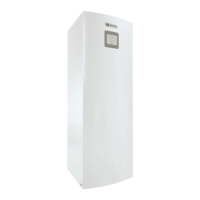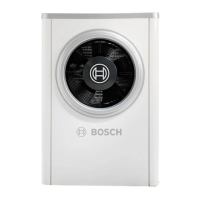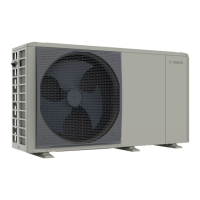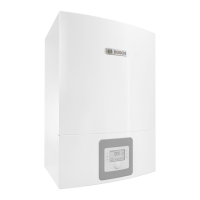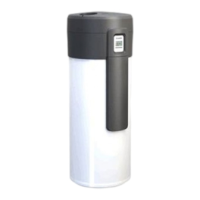Preparing for installation
Compress 5800i AW – 6721858460 (2023/06)
10
Requirements on the fill and top-up water
Fig. 7 Heat generators < 50 kW-100 kW
[x] Total hardness in °dH
[y] Maximum possible water volume over the service life of the heat
source in m
3
[1] Above the curve, only use desalinated fill and top-up water, with a
conductivity of ≤ 10 μS/cm
[2] Below the curve, untreated fill and top-up water according to
drinking water regulation can be used
For systems with a specific system water content >40 l/kW, water
treatment is mandatory. If there are several heat generators in the
heating system, then the system water volume must be related to the
heat generator with the lowest output.
Table 4 Water hardness unit conversion
A recommended and approved method for water treatment is
desalination of the fill and top-up water to a conductivity of ≤ 10 μS/cm.
Prevention of corrosion
In most cases, corrosion plays only a minor role in heating systems.
However, a precondition for this is that the system is a corrosion-sealed
water heating installation. This means that there is practically no access
of oxygen to the system during operation.
Continuous introduction of oxygen leads to corrosion and can thus cause
rusting and rust sludge formation. Sludge formation can not only cause
blockages and therefore a diminished heat supply but also deposits
(similar to lime scale deposits) on the hot surfaces of the heat exchanger.
The amount of oxygen introduced by the fill- and top-up water are
generally very small and can therefore be ignored.
To avoid oxygenation, connection pipes must be diffusion-tight!
The use of rubber hoses should be avoided.
The intended connection accessories should be used in the installation.
During operation, pressure maintenance with regard to oxygen ingress
and in particular the function, correct sizing and correct setting (pre-
charge pressure) of the expansion vessel is of highest importance.
Check the pre-charge pressure and function annually.
Furthermore, the function of automatic air vents should also be checked
during maintenance.
It is also important to check and document the top-up water quantities
via a water meter. Larger and regularly required water top-up quantities
indicate insufficient pressure maintenance, leaks or continuous oxygen
input.
Antifreeze
Unsuitable antifreeze can damage the heat exchanger or cause a fault in
the heat source or DHW supply.
Unsuitable antifreeze can damage the heat source and heating system.
Only use antifreeze as listed in the document 6720841872, which
contains antifreeze products approved by us.
▶ Only use antifreeze according to the specifications of the
manufacturer, e.g with regard to the minimum concentration.
▶ Follow the instructions of the manufacturer of the antifreeze about
regular checking of the concentration and corrective measures.
▶ The use of antifreeze reduces the efficiency.
Heating water additives
Unsuitable heating water additives can cause damage to the heat source
and heating system or cause a fault in the heat source or DHW supply.
The use of a heating water additive, e.g. corrosion inhibitor, is only
allowed, if the manufacturer of the heating water additive certifies its
suitability for all materials in the heating system.
▶ Only use heating water additives in accordance with the instructions
of its manufacturer about concentration, regular checking of the
concentration and corrective measures.
Sealants in the heating water can cause deposits in the heat generator,
therefore it is not advisable to use it.
Suitable water treatment products (inhibitors/cleaners) can be
obtained from the following manufacturers:
Follow the guidance of BS7593:2019
1)
for treatment of water in
domestic hot water heating systems.
Table 5
Quality requirements for the heating water
The quality of the fill and top-up water is an essential factor for increased
efficiency, functional reliability, long service life and for maintaining the
operational readiness of a heating system.
Unsuitable water can damage the heat exchanger or cause a fault in the
heat generator or DHW supply!
Unsuitable or contaminated water can lead to sludge formation,
corrosion or scaling. Unsuitable antifreeze or hot water additives
Water hardness unit conversion
°dH °e °fH ppm mmol/l
1°dH= 1 1,25 1,8 17,8 0,1783
1°e= 0,798 1 1,4 14,3 0,142
1°fH= 0,56 0,7 1 10 0,1
1 ppm
CaCO3
(USA)
0,056 0,07 0,1 1 0,01
1mmol/l= 5,6 7,02 10 100 1
0010048707-001
0,00
0,20
0,40
0,60
0,80
1,00
1,20
1,40
1,60
1,80
2,00
2,20
2,40
2,60
2,80
3,00
0 5 10 15 20 25 30
x
y
< 50 kW
< 100 kW
1
2
1) Only applicable in the United Kingdom
ADEY www.adey.com
FERNOX www.fernox.com
SENTINEL www.sentinelprotects.com/uk

